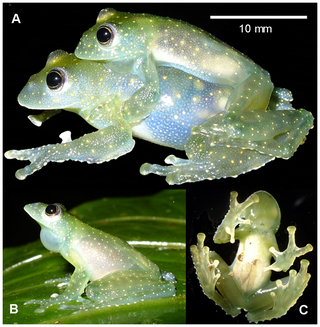
The glass frogs belong to the amphibian family Centrolenidae. While the general background coloration of most glass frogs is primarily lime green, the abdominal skin of some members of this family is transparent and translucent, giving the glass frog its common name. The internal viscera, including the heart, liver, and gastrointestinal tract, are visible through the skin. When active their blood makes them visible; when sleeping most of the blood is concealed in the liver, hiding them. Glass frogs are arboreal, living mainly in trees, and only come out for mating season. Their transparency conceals them very effectively when sleeping on a green leaf, as they habitually do.

The ram cichlid, Mikrogeophagus ramirezi, is a species of freshwater fish endemic to the Orinoco River basin, in the savannahs of Venezuela and Colombia in South America. The species has been examined in studies on fish behaviour and is a popular aquarium fish, traded under a variety of common names, including ram, blue ram, German blue ram, Asian ram, butterfly cichlid, Ramirez's dwarf cichlid, dwarf butterfly cichlid and Ramirezi. The species is a member of the family Cichlidae and subfamily Geophaginae.
Cochranella litoralis is a species of frog in the family Centrolenidae. It is known from the Pacific lowlands of southwestern Colombia and northern Ecuador. The specific name litoralis refers to the proximity of the type locality to the sea.
"Cochranella" duidaeana, commonly known as the Duida Cochran frog, is a species of frog in the family Centrolenidae. It is endemic to Cerro Duida, Venezuela. The generic placement of this species within the subfamily Centroleninae is uncertain.
"Cochranella" euhystrix is a species of frog in the family Centrolenidae. It has an uncertain placement within subfamily Centroleninae. It is endemic to Peru and only known from the vicinity of its type locality near Cerro Blanco, in the Zaña River watershed, Department of Cajamarca. The specific name euhystrix refers to the unusually spiny appearance of this frog, especially males. Common name ridge Cochran frog has been proposed for this frog.

Cochranella euknemos, sometimes known as the San Jose Cochran frog, is a species of frog in the family Centrolenidae. It is found in central Costa Rica and south/eastward to Panama and to the western flank of the Cordillera Occidental in Colombia. Some Colombian records might apply to Cochranella mache.
"Cochranella" geijskesi, also known as the Wilhelmina Cochran frog, is a species of frog in the family Centrolenidae. It is endemic to Suriname. Its natural habitats are subtropical or tropical moist lowland forests and rivers.

Cochranella granulosa is a species of frog in the family Centrolenidae. It is found in Costa Rica, Honduras, Nicaragua, and Panama.
Nymphargus luteopunctatus is a species of frog in the family Centrolenidae, formerly placed in Cochranella. This frog has 2-3 large vomerine teeth and is green with yellow spots bordered by black. When viewed from above it has a rounded snout. It is endemic to the Cordillera Occidental in the Cauca Department, Colombia.

Cochranella mache, also known as the Mache glassfrog or Mache Cochran frog, is a species of frogs in the family Centrolenidae. It is found in the lowland forest and eastern slopes of Cordillera Mache–Chindul in the Esmeraldas Province, northwestern Ecuador, and in the western foothills of the Cordillera Occidental in Colombia.

Cochranella nola is a species of frog in the family Centrolenidae, the glass frogs, so named because of the transparent skin on the underside of the abdomen through which the internal organs can be seen. This species is endemic to Bolivia where it is found in the Andean foothills in the Santa Cruz Department. Its natural habitats are subtropical or tropical moist montane forests and rivers. The scientific name nola is Latin for "small bell", and refers to the high-pitched, bell-like call of the male in the breeding season.

Cochranella resplendens is a species of frog in the family Centrolenidae. It is found in the upper Amazon Basin in southwestern Colombia, eastern Ecuador, northern Peru, and Bolivia. There are also isolated records from the Cordillera Central in Antioquia, Colombia, and Amapá in northern Brazil. The specific name resplendens is derived from the Latin verb resplendo and hints to the jewel-like appearance of this frog. It is sometimes known as the resplendent Cochran frog or resplendent glassfrog.
"Cochranella" riveroi is a species of frog in the family Centrolenidae. It is endemic to Cerro Aracamuni, Venezuela. The generic placement of this species within the subfamily Centroleninae is uncertain.
Rulyrana saxiscandens is a species of frog in the family Centrolenidae. It is endemic to the Cordillera Escalera, Peru, approximately between the cities of Tarapoto and Moyobamba.
"Cochranella" xanthocheridia is a species of frog in the family Centrolenidae. It has an uncertain generic placement within subfamily Centroleninae; molecular data are not available and morphological and behavioural characters do not unambiguously place it in any specific genus.

The powdered glass frog or Chiriqui glass frog is a frog species in the glass frog family (Centrolenidae). The species is found from north-central Honduras south to northwestern Ecuador.
Leucostethus ramirezi is a species of frog in the family Dendrobatidae that is endemic to Colombia. It is only known from the region of its type locality, Urrao in the Antioquia Department. Its natural habitat is sub-Andean forest.

Abronia ramirezi, Ramirez's alligator lizard, is species of arboreal alligator lizard in the family Anguidae. The species, which was described in 1994 by Campbell, is endemic to Mexico.
Emblemariopsis ramirezi is a species of chaenopsid blenny known from Venezuela, in the western central Atlantic ocean. The specific name honours Humberto Ramirez, who found this species and drew Cervigón's attention to it.

Centroleninae is one of two subfamilies of the family Centrolenidae. It has nine genera distributed in Central America from Honduras south and east to northern and central South America. As of mid 2015, it contains 117 species.










